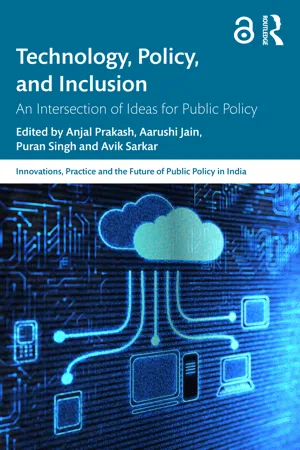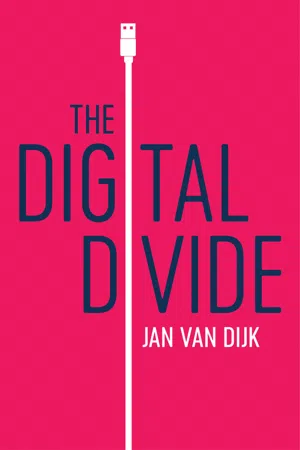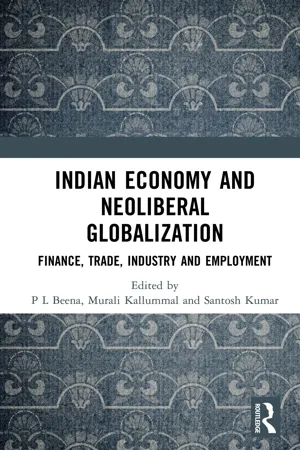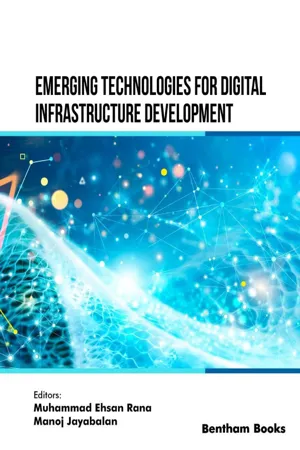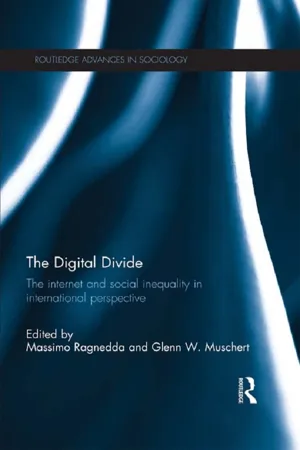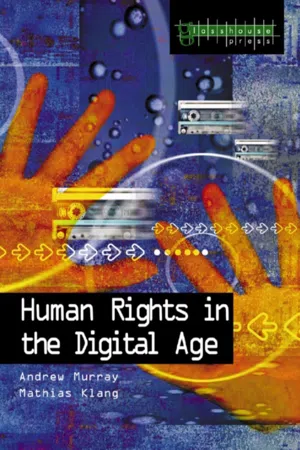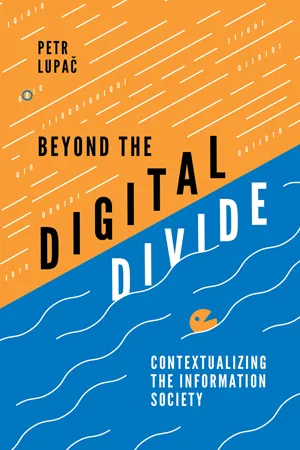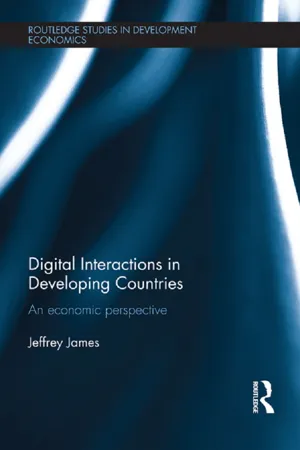Computer Science
Digital Divide
The digital divide refers to the gap between those who have access to digital technologies and those who do not. This divide can be based on factors such as income, education, geography, and age. It encompasses disparities in internet access, computer ownership, and digital literacy, and has implications for social and economic equality.
Written by Perlego with AI-assistance
Related key terms
Related key terms
1 of 4
Related key terms
1 of 3
11 Key excerpts on "Digital Divide"
- eBook - ePub
The Third Digital Divide
A Weberian Approach to Digital Inequalities
- Massimo Ragnedda(Author)
- 2017(Publication Date)
- Routledge(Publisher)
It is useful to explore, albeit briefly here, the rise of the Digital Divide and how it has been approached and analysed by both scholars and policy makers. I shall start by attempting to define the Digital Divide taking into account its complexity. Second, I shall discuss the rise of this issue as a social and public concern, going beyond questions of technological infrastructure and economic issues. I shall end this section by highlighting some of the difficulties and challenges that those wishing to analyse this phenomenon from a multidimensional perspective might encounter.Attempting to define the Digital Divide
The Digital Divide first gained prominence as a policy issue thanks to reports released by the US Department of Commerce’s National Telecommunications and Information Administration (NTIA). The first report was released in July 1995, entitled, ‘Falling through the Net: A Survey of the “Have Nots” in Rural and Urban America’; a second was released in July 1998, entitled ‘Falling through the Net II: New Data on the Digital Divide’, and a third report in July 1999, entitled, ‘Falling through the Net: Defining the Digital Divide’. Based on these reports, the issue came to be included on academic and political agendas in the US. They refer to the socio-economic gap between communities with access to computers and the Internet and those without, in one of the first attempts to define the Digital Divide.At this early stage of its development, the concept of the Digital Divide tended to be seen as the gap between those with access to new technologies and those without (Hoffman and Novak, 1998; Katz and Aspden, 1997). Thus, in its most simplistic terms, the Digital Divide was defined as a form of inequality in access to new ICTs, and in particular to the Internet (Besser, 2004). This approach, taking for granted the availability of a telephone line, distinguishes between those who have a personal computer and a modem, and then can access the Internet, and those who, not having this technology, remain cut off from its possibilities. Such a definition is rather narrow; as we shall see later, this is highly problematic (DiMaggio et al. , 2001; Selwyn, 2004), as the definition fails to understand the multidimensionality of what it means to be connected (Warschauer, 2002). It may be useful in analysing the diffusion of the technology, but is inappropriate if the aim is to analyse and understand the social consequences of this diffusion (Jung et al. - eBook - ePub
Technology, Policy, and Inclusion
An Intersection of Ideas for Public Policy
- Anjal Prakash, Aarushi Jain, Puran Singh, Avik Sarkar, Anjal Prakash, Aarushi Jain, Puran Singh, Avik Sarkar(Authors)
- 2023(Publication Date)
- Routledge India(Publisher)
Norris, 2001 ).FIGURE 7.4 Percentage of Students Having Access to Digital Infrastructure in Rural IndiaSource: Adapted from Reddy et al. (2020)India is a vast country, and it is geographically and culturally very diverse. There are many parts of the country where there is no access to basic facilities. A report in The Financial Express states that India’s Digital Divide remains huge as more than 400 million people still have no access to the internet. The spatial divide is also huge, with the internet density in rural areas where more than 60% of the people live, standing at 25% compared to the internet density in urban areas, which stands at 90% (Ghani & Mishra, 2020 ). Even though 66% of the country’s population lives in its villages, rural internet density is just 25.3% (Paresheera, 2019 ). In comparison, urban areas have a significantly higher density of 97.9%. This means that for every Indian who has access to the internet, there is at least one person who does not have internet access, and that person is most likely living in a rural area (Paresheera, 2019 ). A research study by Neena and Kaur (2014) shows that the inter-state Digital Divide has narrowed down during the period 2001–2012. In 2012, only one state, Himachal Pradesh, turned from medium to high type.1 States are classified as low, medium, or high in terms of the Digital Divide*. States in the low category are the same except for the state of Rajasthan, which moved from the low to the medium category in 2012. According to the annual report of the Telecom Regulatory Authority of India, urban telephone subscribers are calculated to be 656.46 million, and rural telephone subscribers 521.51 million (Telecom Regulatory Authority of India [TRAI], 2020 ). In India, the total number of internet subscribers per 100 population is 55.12 million, and urban internet subscribers per 100 population are 99.12 million, whereas rural internet subscribers are 32.24 million (TRAI, 2020 ). There is much variation in terms of the level of access among different states of India. For instance, states like Bihar, Uttar Pradesh, and Orissa have very low internet density. On the other hand, Kerala is the state where the difference based on internet density is the least (TRAI, 2020 - eBook - ePub
- Jan van Dijk(Author)
- 2020(Publication Date)
- Polity(Publisher)
1 What is the Digital Divide?Introduction: the concept of the Digital Divide
In the year 2020 both the concept of and the research into the Digital Divide will be twenty-five years old. In 1995 the term ‘Digital Divide’ was first used in a number of newspapers in the United States. It was backed by data in the report Falling through the Net, published by the National Telecommunications and Information Administration, which talked about ‘haves and have nots’ (NTIA 1995). Soon the concept spread to Europe and the rest of the world, and by the millennium both the idea and the problematic of the Digital Divide were firmly established on the societal and scholarly agenda.But what does the concept actually mean? It has produced so many definitions, controversies and misunderstandings that several people were in favour of discarding it after a few years (Compaine 2001; Gunkel 2003). The most common definition runs as follows: a division between people who have access and use of digital media and those who do not. The term ‘access’ was emphasized in the first years of discourse, though later the word ‘use’ was highlighted.A common synonym for digital media is the general term ‘information and communication technology’. Access can refer to its devices, connections or applications. The first device to be accessed was a stand-alone computer or a PC, to be followed by a series of digital media, both mobile (mobile phones, laptops, tablets and smartphones) and digitized analogue media (television, radio, cameras and game devices). Connections mentioned were the Internet, mobile telephony and digital broadcasting, with either narrowor broadcasting capacities. Finally, the applications of most interest were e-mail, search engines, e-commerce, e-banking and social-networking sites. - eBook - ePub
Controlling Cyberspace
The Politics of Internet Governance and Regulation
- Carol M. Glen(Author)
- 2017(Publication Date)
- Praeger(Publisher)
The Digital Divide issue lies at the heart of the Internet governance debate. To many around the world, the existing Internet governance framework is perceived as exclusionary, constructed to favor the already powerful. This view is particularly deep seated in countries of the Global South, which, as later adopters of the technology, have had less opportunity to influence the evolution of Internet governance. Moreover, many governments in the Global South argue that the multistakeholder arrangements that have been the hallmark of Internet governance to date perpetuate inequity. They assert that membership in multistakeholder institutions is heavily tilted in favor of the Global North, and that access to the power structures of Internet governance is difficult. The solution to this perceived imbalance therefore lies in transferring decision-making authority in Internet governance to global institutions in which all countries’ votes are weighted equally. From this perspective, this remedy would not only lessen the perceived dominance of the United States in Internet governance, it would substantially increase the influence of the Global South. In institutions where decisions are based on one country, one vote, the Global South benefits from sheer numbers. Although the Digital Divide in Internet governance is fundamentally about gaining access to centers of decision making by governments that feel excluded, the term traditionally has had a broader meaning. The Digital Divide is typically articulated with reference to access to technology by individuals and groups, not access to decision making by governments. With its focus on individual users, this broader definition normally falls outside scholarly analysis of Internet governance, but the two cannot be entirely disentwined. After all, access to Internet governance presupposes access to technology. From a Global South perspective, contributing to Internet governance is not an end in itself. Rather, it is viewed as a means to spread access to technology worldwide.What Is the Digital Divide?
The term Digital Divide was first used in the 1990s to depict the gap that existed between those who had access to information technologies, and those who did not. The phrase was originally applied to the uneven distribution of Internet resources in the United States. A landmark 1995 study titled Falling Through the Net: A Survey of the “Have Nots” in Rural and Urban America found that inner cities and rural areas of the South had the least access to information and communication technology (ICT), prompting federal and state governments to increase funding for computers and Internet connectivity, especially in schools.1 The Digital Divide was therefore viewed in dichotomous terms, either people have access to technology or they do not. If it is the latter, then the solution is relatively straightforward; simply provide more ICT and the Digital Divide will be transformed into digital inclusion.This technocratic optimism was also evident at the global level. The Digital Divide was seen as an inevitable phenomenon that, like previous technologies, gave early innovators advantages over late adopters. However, these advantages are not static. Laggards have opportunities to catch up as the technology spreads. Indeed, the Internet has the potential to shorten economic development timelines for later adopters. For instance, instead of laying thousands of miles of telephone wires, technology laggards can skip that old technology and build cell phone towers instead. This has already occurred. Between 2011 and 2013, the number of mobile broadband subscriptions in developing countries more than doubled, and they surpassed those in developed countries by 2013.2 These encouraging statistics seem to bolster the argument that the Digital Divide is a temporary phenomenon; it will eventually disappear due to the rapidly declining cost of technology and its consequent diffusion. However, availability of technology does not equate to adoption of that technology. In 2015, 84 percent of the population in Sub-Saharan Africa had a mobile signal, but only 8 percent had adopted the technology.3 - eBook - ePub
Indian Economy and Neoliberal Globalization
Finance, Trade, Industry and Employment
- P L Beena, Murali Kallummal, Santosh Kumar, P L Beena, Murali Kallummal, Santosh Kumar(Authors)
- 2022(Publication Date)
- Routledge India(Publisher)
Sridhar and Sridhar (2007) among others. However, the penetration of ICTs has largely been concentrated in urban areas and among males thereby creating a Digital Divide. This chapter is divided into six sections. While the first section gives introductory remarks, the second section defines the concept of Digital Divide. The third and fourth sections look at the nature and extent of this divide globally and within India respectively. The fifth section analyses the policy measures to bridge the divide, and finally, the sixth section provides the concluding remarks and some policy suggestions.Defining the Digital Divide
ICTs not only positively contribute to the facets mentioned above, they also act as a medium to bridge the Digital Divide. According to the Organisation for Economic Co-operation and Development (OECD), the term Digital Dividerefers to the gap between individuals, households, businesses and geographic areas at different socio-economic levels with regard to both their opportunities to access ICTs, and to their use of the Internet for a wide variety of activities. It reflects various differences among and within countries.(pg. 5, OECD, 2001 )Compaine (2001) defines the Digital Divide in terms of the perceived gap between those who have access to the latest information technologies and those who do not. The Digital Opportunity Task Force (DOT Force) calls ita reflection of existing broader socio-economic inequalities and can be characterized by insufficient infrastructure, high cost of access, inappropriate or weak policy regimes, inefficiencies in the provision of telecommunication networks and services, lack of locally created content, and uneven ability to derive economic and social benefits from information-intensive activities.(DOT Force, 2001 )To put it simply, the term is used to describe situations where there is a marked gap in accessing ICT services through devices, with communications infrastructure, computer availability and internet access being the important indicators. They are generally measured in terms of fixed-line phones per inhabitant or number of mobile phones per inhabitant or number of internet connections and/or users per inhabitant.The term Digital Divide is argued to have gained importance when it became a part of the title of the second National Telecommunications and Information Agency (NITA), USA, survey in 1998. While its origin has not been attributed to any particular author, it caught up as a catchy label for different agencies to study its causes and measure it (Compaine, 2001 - Muhammad Ehsan Rana, Manoj Jayabalan(Authors)
- 2000(Publication Date)
- Bentham Science Publishers(Publisher)
4 ].In the early days of ICT diffusion, several studies defined the Digital Divide regarding availability and accessibility only [5 - 8 ]. Later the use or adoption of ICT received the attention of researchers [9 ] in developed nations. As the availability issue has been vastly reduced, fixed terrestrial high-speed broadbandat speeds of 25 Mbps/3 Mbps is available for 92.3 per cent of Americans [10 ] However, the usage issue isn’t solved still, and a few researchers view the use as the second-level Digital Divide [11 ]. These studies predominantly examine the hours, days, and weeks of computers and Internet usage, taking everyday activities, such as web browsing, social networking, watching videos, listening to music, playing games, checking or sending an email, and uploading or downloading applications into consideration. Without usage, the aims of ICT are unachievable. The Digital Future Report finds that 77 per cent of Americans use the Internet daily, and 17 per cent use it at least once a week [12 ]. Others measure use by bandwidth usage. Hilbert, in his research, suggested improving “the intensity of usage” [13 ] by traffic flow per time unit and admitted the absence of internationally recognised measures on effective ICT usage.ITU [14 ] has a similar measure of ICT use. For a computer, the measurement consists of nine activities ranging from simple copying or moving a file or folder to an advanced activity of writing a program using a programming language. Twenty-nine Internet activities are used, ranging from getting information about goods or services to online banking. Many of these activities have become partly routine for many users in their daily lives. As Giddens says, human actors maintain stocks of knowledge to perform day-to-day social activities [15- eBook - ePub
The Digital Divide
The Internet and Social Inequality in International Perspective
- Massimo Ragnedda, Glenn W. Muschert, Massimo Ragnedda, Glenn W. Muschert(Authors)
- 2013(Publication Date)
- Routledge(Publisher)
Wessels, 2010 ).Some of the dimensions of the Digital Divide are as follows. First, ethnicity, age, gender, levels of education and socio-economic background and status are influential in the dynamics of the Digital Divide (Wessels, 2010 ). Second, there is a technological divide amongst world regions with different levels of infrastructure that prevent some regions linking into a global economy. Third, as Zillien and Marr (in Chapter 3 of this volume) point out, there is widening knowledge gap for those with low access, low skills, and little cultural capital to use digital resources. These dimensions configure in different ways across the globe. In the US the ethnic divide is still significant amongst digital inequalities (Wessels, 2010 ; Witte, Kiss and Lynn, Chapter 4 of this volume). The contributors of this volume show that the Digital Divide in developing countries is uneven with some cities and regions developing rapidly whilst others are disconnected. There are specific development needs of particular countries and if access and support is not provided inequalities will deepen, as seen for example in the Latin American context (Horwitz, Chapter 16 of this volume). Status and cultural factors interact with the take up of digital services, which fosters inequalities seen for example in Sub-Saharan Africa (Alzouma, Chapter 19 of this volume) and in Japan (Akiyoshi, Chapter 5 of this volume). Faris (Chapter 13 of this volume) outlines the dynamics of a democratic divide in accessing an online public sphere. The dynamics of these aspects are fostering greater inequality globally as the gap between the wealthy and poor widens around the Digital Divide (Castells, 2001 - eBook - ePub
- Nick Rushby, Dan Surry, Nick Rushby, Dan Surry(Authors)
- 2016(Publication Date)
- Wiley-Blackwell(Publisher)
In the late 19th century lantern-slide technology was introduced, which allowed for the projection of visuals onto a large screen (Seattler 1990). This precursor to the slide projector, or even the video projector, was seen as a modern marvel. For the first time a speaker could project visuals in front of an audience, and people would pay money and crowd rooms to hear and see talks about faraway places. Scholars and adventurers showed slides of places they had visited and discussed them with large audiences of rapt listeners. What was truly remarkable about this, beyond the fact that people once willingly looked at vacation pictures, is that it opened up a world of visual information to people who previously did not have that access. People began to see the value of this technique for presenting information. Having multiple channels of information—visuals and audio—provided for increased redundancy in the message. The educational value of the technique was recognized and employed in classrooms. Learning organizations, schools in this case, were among the leaders in adopting this technology.The move from lantern-slide presentations as a public novelty to an educational staple is not an isolated incident. Clearly computer and Internet access have taken that path. For many new technologies, it is often their use by learning organizations that helps provide initial access and later to promote universal access. However, not all learning organizations are equal. Better-funded schools have better access than poorer schools. Schools in the developed world have greater access than schools in the developing world, which is, of course, how we get to the idea of the Digital Divide.18.4 The Digital Divide
As early as the 1960s, early computer scientists and programmers were concerned about universal access to computers. Steven Levy recounts the early days of computers when a group of programmers in the San Francisco Bay area predicted that having access to computer terminals would link people together with efficiency never before seen, and change the world for the better (Levy 1984). Even in the early days of computing, where dumb terminals were useless unless connected to an expensive main-frame computer, programmers could see the advantage that such a connection could give to a person. They may not have been able to predict the Internet, but their concerns were warranted, echoed by many, and look much like the concerns we see today (Levy 1984).The term “Digital Divide” is often used to describe the idea of equity of access. The history of the term helps frame the discussion of how we view and manage issues of equity of access. It appears to have been coined by Albert Hammond and Larry Irving at the National Telecommunications and Information Administration (NTIA), the US government agency responsible by law for advising the President of the United States on telecommunications and information policy issues. The term gained prominence during the 1990s, largely because it was used often by President Bill Clinton and Vice President Al Gore during speeches about the need to address issues of access to technology and communication resources. During the early and mid-1990s, communication techniques were moving from analog to digital. Electronic mail was introduced and soon became a necessity for communication in all walks of life. The World Wide Web (WWW) was becoming available thanks to the creation of early web browsers like Mosaic and Netscape. The effect of this was to shine a light on the disparity between those who had access and those who did not (Rappaport 2009). - eBook - ePub
- Mathias Klang, Andrew Murray, Mathias Klang, Andrew Murray(Authors)
- 2016(Publication Date)
- Routledge-Cavendish(Publisher)
7For others, however, national and international disparities in the diffusion of information and communication technologies (ICTs), and especially access to the Internet and the Web, are a source of great consternation. The essence of this apprehension was aptly summarised in the United Nations’ 1999 Human Development Report:The network society is creating parallel communications systems: one for those with income, education and – literally – connections, giving plentiful information at low cost and high speed; the other for those without connections, blocked by high barriers of time, cost and uncertainty and dependent upon outdated information.8This view is linked to a broader discourse emphasising the potential social, economic and political benefits to be reaped through the implementation of ICTs. According to enthusiasts, increasing Internet penetration rates and overcoming access-related obstacles should be high on international and national policy agendas because digital technologies are a sine qua non for reducing barriers to trade, enhancing access to information, and expanding social networks.9For developed countries, the key issue is seen to reside in ensuring that access to the Internet diffuses in an equitable manner across population segments. Developing countries, on the other hand, are encouraged to implement policy initiatives oriented toward upgrading existing ICT infrastructures and increasing the rate of growth of telecommunications networks. Broadband technology, in particular, is seen as prerequisite for providing the technical capacity needed to ensure inclusion into some abstract model of how the knowledge-based economy manifests itself. In its most radical articulation this technologically deterministic vision implies that the Internet and the Web are magic bullets for social and economic development.10 - eBook - ePub
- Petr Lupač(Author)
- 2018(Publication Date)
- Emerald Publishing Limited(Publisher)
This is akin to the once popular issue of unequal computer and Internet access in the school system, an issue that has become obsolete in countries producing the highest number of Digital Divide-related texts as a result of government programmes promoting the computerization and Internetization of the school system – in the United States, 98% of public schools were connected to the Internet in 1998, the EU reached 96% by 2006, with none of the member states falling below 90%. 87 Proponents of the Digital Divide thesis were then drawn to other research issues: differences between schools in terms of the quality and quantity of ICT, 88 exploring the relationship between education and user skills and adjusting the impact of independent variables and determining the significance and weight of their impact. Fig. 4.8: Evolution of Internet Users by Formal Educational Attainment in EU-27, 2004–2016. Source : Author from Eurostat (2017) database Since income, traditionally the focal point of social inequality studies, is correlated with all of the sociodemographic attributes detailed here (education, gender, age…), it is evident that the picture of the Digital Divide will not differ greatly when comparing different income categories. Current EU data reveal only a slow narrowing of the Digital Divide, illustrated via differences in household income (see Fig. 4.9) - eBook - ePub
- Jeffrey James(Author)
- 2013(Publication Date)
- Routledge(Publisher)
In each context, the debate has turned mainly on the measurement of the Digital Divide and how best to overcome it. Meso et al. (2006), for example, have investigated the potential for good governance to accelerate the integration of developing countries into the global economy by means of policy-making regarding IT. According to this view, the impact of such technology on socio-economic factors is powerfully conditioned by the role of the state (a positive impact is perhaps best exemplified among developing countries in East Asia such as Korea, Taiwan and Singapore). Another paper from the same year is also concerned with bridging the Digital Divide. In particular, Kifle et al. (2006) investigate the viability of telemedicine in developing countries that lack a basic health-care infrastructure. A helpful way to conceive of the relationship between the Digital Divide and digital preparedness is that the latter contains inputs that determine the former. Following basic economic principles, the one concept is about inputs and the other is about the product of those inputs. We now know the most important determinants (e.g. education and infrastructure) of the Digital Divide between rich and poor countries. 1 There is much less discussion, however, of how these variables relate to one another. Yet it is on the outcome of such a discussion that one’s view of the difficulty of closing the divide ultimately depends. Implicit in the existing digital preparedness literature (i.e. a literature that measures the readiness of countries to exploit IT) is the optimistic assumption that the components of a composite index can be perfectly substituted for one another and, hence, can be added together into a single number (i.e
Index pages curate the most relevant extracts from our library of academic textbooks. They’ve been created using an in-house natural language model (NLM), each adding context and meaning to key research topics.
Explore more topic indexes
Explore more topic indexes
1 of 6
Explore more topic indexes
1 of 4

